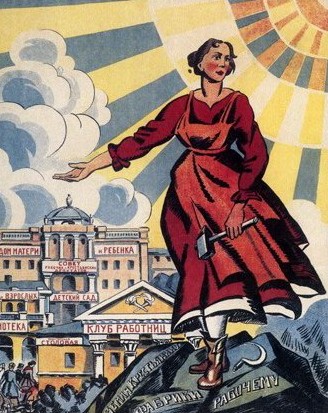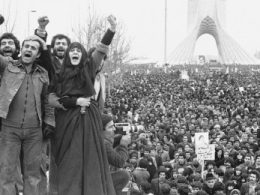Young people internationally are being politicised by the oppression of women and LGBT people, opening up debates as to how this discrimination and inequality can be ended. EMMA QUINN looks at the experience of the Russian Revolution and the radical progressive measures introduced by the Bolsheviks that were seen as part of the initial steps to bring about the full liberation of these two oppressed groupings.
No other event in history has been more distorted by the capitalist establishment than the Russian Revolution. Within revisions of the revolution, the role of women is scarcely mentioned, the massive gains for women won by the revolution even less so.
The complete overthrow of capitalism and landlordism by the Bolshevik Party and Russian working class in 1917 spurred a radical change in society, the likes of which had never been seen before or since. The Bolsheviks were able to take power precisely because they were the voice of the oppressed masses, workers, the poor and women. Wealth inequality and oppression have never been more glaring than today, the combined wealth of the richest 1% will overtake that of the other 99% of the world’s population in 2016. Amidst this increasing inequality, the oppression of women and the LGBT community worldwide continues even in the most developed countries and is a hugely politicising and important issue for young people in particular, in Ireland and internationally. In this context it is important to draw out the lessons of the past, and there are none more important than those we can learn from the Russian Revolution.
The Bolsheviks, while stressing the role of the working class as a whole in changing society, recognised that women suffered a double oppression that was routed in capitalism and peasant patriarchy. For the Bolsheviks, the liberation of women was pivotal to the fight for a socialist society. Lenin encapsulated the importance of this in 1920 when he declared that “the proletarian cannot achieve liberty until it has won complete liberty for women”.[i] Women played leading roles in the Bolshevik Party at both national and local levels and the impact of the revolution transformed the consciousness and lives of working class women on a broad scale.
Anti-war agitation and the Bolshevik women
In the run up to the revolution, women played a significant role both in the downfall of the Tsarist regime and the victory of the Bolsheviks. More than any other political force at the time, the Bolsheviks knew and understood the significance of this. When tens of thousands of women took to the streets in February 1917, in the events that triggered the February Revolution, their demands were for justice and peace, as well as bread. The protest erupted on International Women’s Day, which was itself introduced to Russia by Bolshevik activist Konkordia Samoilova only four years previously in 1913.[ii] Bolshevik women played a key organising role in the building of the demonstration. They set up a city-wide women’s circle agitating amongst women workers and soldier’s wives despite continual harassment by authorities. The Bolshevik Party, including its female members had suffered severe repression from 1914 because of their staunch opposition to World War 1, with many imprisoned or exiled. This and the brutality that the war inflicted on the working class inspired them to commemorate International Women’s Day with an anti-war demonstration. On 23 February, the working class of Petrograd spilled onto the streets with women taking the lead calling for people to join them and appealing to soldiers to hold fire and to march with them.
International Women’s Day 1917
“On Women’s Day, 23 February 1917, a strike was declared at the majority of factories and plants. The women were in a very militant mood – not only the women workers, but the masses of women queuing for bread and kerosene. They held political meetings, they dominated the streets, they moved to the city duma with a demand for bread, they stopped trams. “Comrades, come out!” they shouted enthusiastically. They went to factories and plants and summoned workers to down tools. All in all, Womens Day was a tremendous success and gave rise to the revolutionary spirit” wrote Anna and Mariia Ul’ianov in Pravda on 5 March 1917.[iii]
The Bolsheviks recognised the significance of the radicalisation of women in the summer that followed the February Revolution when a wave of strikes erupted that included laundry workers, the service sector, domestic servants, shop assistants and waitresses. During this period, the Bolsheviks were to the fore of organising women workers. The Bolsheviks, particularly the female members, expended massive effort to reach female workers and soldier’s wives and were successfully able to build a base amongst this newly politicised layer of women – despite the difficulties of ingrained sexism, their domestic responsibilities and illiteracy amongst many. Sofia Goncharskaia, a member of the Bolshevik Party, headed the Union of Laundry Workers and played a key role in their action.[iv] Revolutionary women established female study circles amongst strikers in an attempt to politicise and educate the women. Through the strike action, women were pulled into the wider labour struggle and their class consciousness cemented. When the Bolsheviks seized power and overthrew the provisional government in October, there were more women who stormed the Winter Palace than defended it, though the opposite is often cited.
Most progressive laws in history
On the 17 December 1917, just seven weeks after forming the world’s first workers’ state, religious marriage was abolished and very easily accessible divorce was legalised. The following month the Family Code was brought into law. The code enshrined legal equality for women and abolished the “illegitimacy” of children. Significantly, and emphasising how vital this was seen to be, the Family Code was introduced by the Bolsheviks while simultaneously trying to end the world war, prevent a civil war, free the peasantry and kick-start industry and the economy.
Throughout the 1920s, the Family Code was added to and each change was accompanied by full public discussion and debate. From its earliest days Russian Socialist propaganda argued for equality for women, but the keystone for the Bolsheviks was women’s enslavement in the traditional family. Before the revolution, a woman’s life was strictly mapped out – get married, be monogamous, have children be tied to “the eternal drudgery of the kitchen and the nursery”.[v] The quality of the lives of women was never considered and their happiness and pleasure were irrelevant. The Bolsheviks immediately set about challenging this and with it the role of the Russian Orthodox Church and patriarchy.
Inessa Armand, director of Zhenotdel, the Women’s Bureau that was established, said, “as long as the old forms of the family, home life and child rearing are not abolished it will be impossible to destroy exploitation and enslavement, it would be impossible to build socialism.”[vi]
Challenging the traditional family
The revolution made a heroic effort to destroy the so-called ‘family hearth’ and began to implement plans for a system of social care that included maternity houses, clinics, schools, crèches and kindergartens, social dining rooms and laundries, all aimed to relieve women from the constraints of the home. Paid maternity leave both before and after birth was introduced for women workers and access to nursing rooms in workplaces to allow breastfeeding, with breaks every three hours for new mother, were written into employment laws.
Abortion was legalised in 1920 and was described by Leon Trotsky as being one of a woman’s “most important civil, political and cultural rights”.[vii] Abortion was free and available through the state, and working women were prioritised.
In November 1918, the first All-Russian Conference of Working Women met, organised by Alexandra Kollontai and Inessa Armand, with over a thousand women in attendance. The organisers reiterated that women’s emancipation went hand in hand with the building of socialism.[viii]
It wasn’t long after these changes were made that the forces of reaction launched a civil war on the country that had already been savaged by World War 1. Shortly after the war began, the Women’s Bureau, or Zhenotdel, was established. Its aim was to reach out to women, bring them to activity and education and inform them of their new rights. The bureau ran literary classes, political discussions and workshops on how to organise facilities needed in the workplace such as day cares etc. Delegates of women from factories attended education courses run by the bureau that lasted three to six months, and then returned to report to their co-workers.
The Women’s Bureau were successful in raising consciousness amongst masses of working women on a range of issues, including child-care, housing and public health and broadened the horizons of thousands of women. By 1922 the number of female members of the now Communist Party exceeded 30,000.
Despite war shortages, the Red Army provided the Women’s Bureau with a dedicated train and access to the railways, enabling them to travel around the country, building local branches of the bureau. Thousands of women joined. The branches held small as well as large meetings and discussion circles that specifically discussed issues affecting women.
Kristina Suvorova, a house wife from a small town in the North of the country described the relationship and the sense of inclusion she felt during weekly meetings between soldiers wives like herself and the local Bolshevik party secretary: “We talked about freedom and the equality of women, about warm sinks for rinsing clothes; we dreamed about running water in the apartment… the local party committee treated us with sincere attention, respectfully listened to us, delicately pointed out our errors, little by little taught us wisdom and reason. We felt like we were one happy family.”[ix]
Sexual freedom
Throughout the post-revolutionary period the Bolsheviks ensured there was wide and fee ranging debate on sexuality, a sea change from the previous regime, even as they struggled to hold out for socialist revolution in other countries, and that came directly from their philosophy of the self-emancipation of the working class.
The changes introduced to the family and the family structure led many to completely change how they approached relationships. In 1921, a survey in Communist Youth showed 21% of men and 14% of women found marriage ideal. 66% of women preferred long term relationships based on love and 10% preferred relationships with different partners. In 1918 there were 7,000 divorces compared to only 6,000 marriages in Moscow.
Alexandra Kollontai defended the radical changes and explained that “The old family in which the man was everything and the woman was nothing, typical family where the women had no will of her own, no time of her own and no money of her own is changing before our very eyes…”[x]
The Bolsheviks believed relationships should be based on choice, personal compatibility and not financial dependence. They attempted to undermine the patriarchal family by providing public services to replace household activities and allow for free leisure time, which they saw as part in parcel to building socialism.
Between 1917-1920s sex debates, explorations and experiments spread across the country. Hundreds of pamphlets, magazines and novels were written about sex. The radicalisation of society didn’t stop after the revolution. Pravda printed many articles and letters debating sex. Young people in particular were keen to explore their sexuality, a young woman Berakova wrote in the Red Student 1927:
“I feel girls like us, while we still haven’t achieved full equality with men still have sense and vision. The Cinderellas are all gone. Our girls know what they want from a man, without any worries many of them sleep with men because of a healthy attraction. We are not objects or simpletons that men should court, girls know who they choose and with whom they sleep.”[xi]
This was written in a country where only a decade before, abortion, divorce and homosexuality were outlawed.
Prostitution was deliberately decriminalised in 1922, but pimping was outlawed. Clinics that treated women with STIs and provided sex education and job training were opened. Trotsky described prostitution as “the extreme degradation of women in the interests of men who can pay for it”.[xii]
Bolshevik sex crime laws were distinctive in their gender neutrality and rejection of morality and moral language. The law enshrined sex crimes as, “Injurious to the health, freedom and dignity” of the victim. Rape was defined by law as “non-consensual sexual intercourse using either physical or psychological force.”[xiii]
By 1921 the Civil War was over, millions of lives lost, industries destroyed, famine, hunger and disease was rife. The real resources of the state did not correspond with the vision and intentions of the revolutionaries. The economy teetered on the brink of collapse. By 1921, radical measures were demanded and the government introduced New Economic Policy (NEP), which included a limited amount of market mechanisms in an attempt to keep the economy going while they held out for the support of the international working class via another revolution in Germany, a major capitalist economy in which there was a mass socialist working class movement and revolutionary stirrings. The NEP was an attempt to restore production in this context, but resulted in cuts to services, in order to maintain the workers’ state while agitating for an international spreading of the revolution.
Given the reality that the state couldn’t financially afford to provide for children and it was common for men to abandon mothers, the state began to issue child support orders for women struggling alone to provide for families. The state printed pamphlets and leaflets so women knew their rights. The courts were biased in favour of women and prioritised the child over the financial interest of the men. In one occasion a judge split the payment three ways because the mother had been in a relationship with three potential fathers.
LGBT lives transformed
The Russian Revolution also changed the lives of LGBT people. Under the Tsar, homosexuality was outlawed, “sodomy” illegal; lesbianism, like women’s sexuality generally, was completely ignored. After the revolution homosexuality was decriminalised when all anti-gay laws were removed from the Criminal Code in 1922.
In his essay, “Sex and Sexuality in Russia” Jason Yanowitz describes the impact that the revolution had on gay, lesbian and transgender people. Surviving memoirs show many gays and lesbians took the revolution as a chance to live open lives. Same sex marriage was legal, how wide-spread it was is unknown as limited research has been conducted, but at least one court case established its legality. There were people who decided to live as the opposite gender following the revolution and by 1926 it became legal to change your sex on passports. Intersex and trans people received medical care and were not demonised. Research on these issues were state-funded and permission was granted to perform gender reassignment surgeries at the request of the patient. Openly gay people were allowed to serve in government and public positions. Georgy Chicherin, for example, was appointed Commisar for Foreign Affairs in 1918. He was an openly gay man with a flamboyant style. It is inconceiveable that such an individual would be given this role by any capitalist state.
In 1923, the Commissar of Health led a delegation to the Institute for Sexual Science in Berlin and described the new laws around homosexuality as being “deliberately emancipatory, widely accepted in society and no one looking to repeal them”.[xiv]
Stalinist Counter-Revolution attacks the gains
Years of war against supporters of the Tsar, and imperialist armies intent on smashing the new workers’ state, and crucially the inordinate isolation of the revolution in the context of defeats for the German Revolution and other working class uprisings in Europe, created the conditions for a bureaucracy to come to power under Stalin. This represented a political counter-revolution, with Stalin and the bureaucracy using authoritarian measures to smash working class consciousness, activism and democracy at home; using their authority to prevent victories for the socialist movement abroad; all in the interests of consolidating the privilege of a bureaucracy at the top of a planned economy. This counter-revolution not only moved away from the struggle for socialism, a society that has democracy in every field of work at its heart, but also consciously attacked the gains of women and LGBT people. Progressive laws were retracted. Homosexuality was criminalised again. The patriarchal family was encouraged as a means of social control. In the famous song from the working women’s movement of the early 20th century, “Bread and Roses”, the line, “the rising of the women means the rising of us all” sums up the need that the bureaucracy had to attack the gains made by women in an effort to regress working class consciousness, activism and agency as a whole.
Incredibly inspiring legacy
The rise of the bureaucracy and Stalin’s betrayal of the revolution and reversal of the gains made does not diminish the significance of the Bolsheviks and their programme. Never before had women had such a stake in politics. Never before had a leadership or political force attempted to secure the support of women or the LGBT community and consider their quality of life and happiness. Some of the achievements gained by the Russian Revolution almost a century ago still do not exist in many countries today, including Ireland where the Church and State are still linked, and a heinous constitutional ban on abortion persists. The October Revolution remains an undeniable and inspirational testament to the inextricable connection between the fight against all forms of oppression, and the working class struggle for a socialist change. It’s absolutely incredible that, for example, some transgender rights were recognised, decades before the women’s liberation and gay liberation movement developed.
The restoration of capitalism in Russia has been disastrous. Neo-liberal capitalism ushered in an era of rapidly declining living standards. This, and the appalling and grave oppression of the LGBTQ community in Russia today point to the utterly reactionary nature of the capitalist system. Capitalism in Russia has meant anything but progress and democracy. Gains made a century ago by the Marxist movement are an anathema to the reactionary Putin regime, one of the most dangerous for LGBTQ people in the world.
The movement that erupted in the South of Ireland around the Marriage Equality Referendum in spring of 2015, and the growing movement in the North for this right, is evidence that working class communities desire social as well as economic equality and are prepared to challenge the establishment. Women in Ireland have borne the brunt of a brutal austerity regime and it was those women who have emerged to play central roles in the referendum as well as in the battle against water charges in the south.
The Russian Revolution shows that the working class is the most powerful force in society and it is only the conscious building of a movement for the 99% that can bring a halt to the thriving inequality for women, for the LGBTQ community and the poor. And like the Bolsheviks did, we must realise that capitalism simply cannot be defeated without women and in particular working class women, being to the fore of the struggle against the 1%.
[i] VI Lenin, On the emancipation of Women, Progress Publishers, 1977, Pg 81
[ii] Jane McDermid and Anna Hillyar, Midwives of the Revolution – Female Bolsheviks and Women workers in 1917, UCL Press, 1999, pg 67-68
[iii] Ibid. pg 8
[iv] Ibid. pg 9
[v] VI Lenin, On the emancipation of Women, Progress Publishers, 1977, Pg 83
[vi] Karen M Offen, European Feminism 1700-1950, Standford University Press 2000, Pg 267
[vii] Leon Trotsky, The Revolution Betrayed, Dover Publications 2004, Pg 113
[viii] Barbara Alpern Engel, Women in Russia 1700-2000, Cambridge University Press 2004, pg 143
[ix] Ibid. pg 142
[x] Alexandra Kollontai, Communism and the Family, 1920
[xi] From Jason Yanowitz’s podcast, “Sex and Sexuality in Soviet Russia, http://wearemany.org/a/2013/06/sex-and-sexuality-in-soviet-russia
[xii] Leon Trotsky, The Revolution Betrayed, Dover Publications 2004, Pg 112
[xiii] http://wearemany.org/a/2013/06/sex-and-sexuality-in-soviet-russia
[xiv] Ibid.












